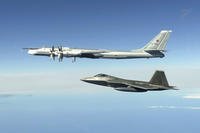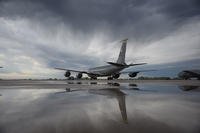A Navy P-8 Poseidon submarine hunter flew over an area off Australia's western coast for the first time Sunday to search for debris from missing Malaysian Airlines Flight 370, the U.S. 7th Fleet reported.
The P-8 and its crew had been flying out of Kuala Lumpur, Malaysia, but were moved to Australia after the Malaysian government shifted the search to an area about 1,500 miles southwest of Australia after Austrian satellite images spotted potential debris last week.
The P-8 flew out of Perth, Australia, and flew a nine-hour roundtrip with the crew using the aircraft's advanced sensors to conduct a wide-area surveillance for the missing passenger jet, officials said.
The remote area in the Indian Ocean is where Australian satellite images spotted potential debris last week. China also reported spotting similar potential debris from its satellites.
The Chinese and Australian sightings were abour 80 miles apart, and a third sighting reported Sunday by a French satellite was in the same general area.
And on Monday an Australian patrol aircraft reported seeing some debris -- circular and rectangular in shape -- but so far the objects haven't been directly linked to the missing Malaysian Airlines flight, according to a report posted at CNN.com.
A Navy P-3 Orion surveillance aircraft has been assigned to another Indian Ocean search area near the Australian territory of the Cocos Islands, about midway between Australia and Sri Lanka. The P-3 did not fly Sunday, the Navy said.
In a phone call Friday with Defense Secretary Chuck Hagel, Malaysian Defense Minister Hishammuddin bin Tun Hussein asked that the U.S. consider assigning undersea surveillance equipment to the search.
Hagel plans to "assess the availability and utility of military undersea technology for such a task and provide him an update in the very near future," Rear Adm. John Kirby, the Pentagon press secretary, said.
The Malaysian request reportedly centered on U.S. hydrophone technology for detecting underwater sound, such as the "ping" emitted by airliner black boxes. On Monday, Stars and Stripes reported that the U.S. Navy had sent a "Towed Pinger Locator 25," a black box locator system that is a "super sensitive hydrophone" able to hear signals to a depth of 20,000 feet, according to Cmdr. Chris Budde, the U.S. 7th Fleet Operations Officer.
The Navy also is developing remotely operated underwater vehicles, designed to detect underwater mines that could be useful in the search for the missing Boeing 777.
In addition to the P-8, seven aircraft and one ship conducted Sunday's search. The search was split into two areas that covered a total of about 23,000 square miles, the Australian Maritime Safety Authority said.
Despite reports of bad weather in the search area, the P-8 was able to use its "full spectrum electronic and visual search capability," the 7th Fleet said.
The P-8 and the P-3 are all-weather aircraft and "even when the weather is bad we don't give up the radar search and exclusively switch to visual -- we simply adjust and search smarter," said Cmdr. William Marks, a 7th Fleet spokesman.
"The radar can alert a crew that something abnormal exists on the surface of the ocean, whether it be a ship, a life raft, or a small object," Marks said. "Then the electro-optical/infrared camera can provide the visual picture, acting as the eyes of the crew day or night."
-- Richard Sisk can be reached at Richard.Sisk@monster.com.





























